Homemade Sourdough Bread, Step by Step
This post may contain affiliate links. Please read my disclosure policy.
If you love fresh sourdough bread with a golden, crisp crust and a light, airy crumb, this recipe is for you. It’s one of the simplest homemade sourdough bread recipes, and one of the best, too. It requires only 25 minutes of hands-on work and no autolyse or preferment. Below you will find guidance for every step of the way. 🍞🍞🍞
⭐️⭐️⭐️⭐️⭐️ Review:
“Absolutely the best sourdough recipe EVER! I have been baking bread for years (sourdough included,) and things were many times hit or miss. Not with your recipe. You have nailed it. I thank you!” — Rosemary Patterson
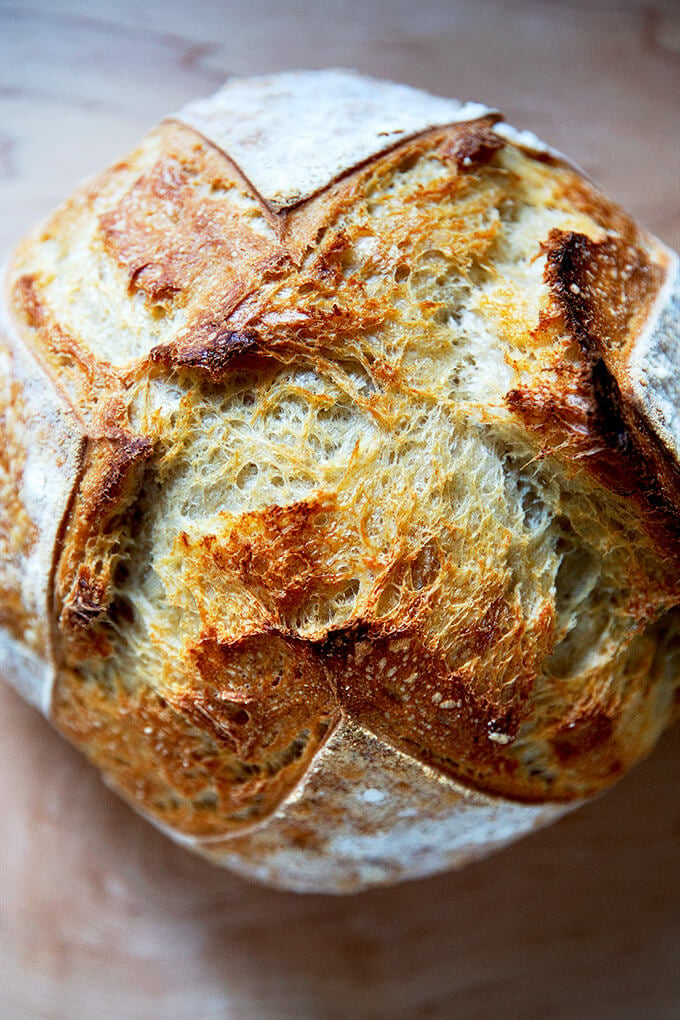
This post will show you how to make the simplest of simple sourdough breads. There is no autolyse or preferment, which means the dough itself comes together in less than five minutes.
For those intimidated by sourdough bread baking, this recipe, as well as this sourdough focaccia recipe, are the recipes I suggest making first, both for their simplicity and flavor. Another great beginner’s bread recipe to try is this overnight, refrigerator focaccia or my mother’s simple peasant bread recipe, both of which require minimal effort but yield spectacular results.
This post is divided into 13 sections:
- What is Sourdough Bread?
- What is a Sourdough Starter?
- How to Feed a Sourdough Starter
- When is My Starter Ready to Be Used?
- Equipment
- How to Make Sourdough Bread: A 5-Step Overview
- How this Sourdough Bread Recipe Differs From Others
- Simple Sourdough Bread: A Step-by-Step Guide
- #1 Sourdough Bread Baking Tip
- Troubleshooting: Where Sourdough Goes Wrong
- Sourdough Baking Resources
- Other Sourdough Bread Recipes to Make
- Sourdough Bread Baking Schedule
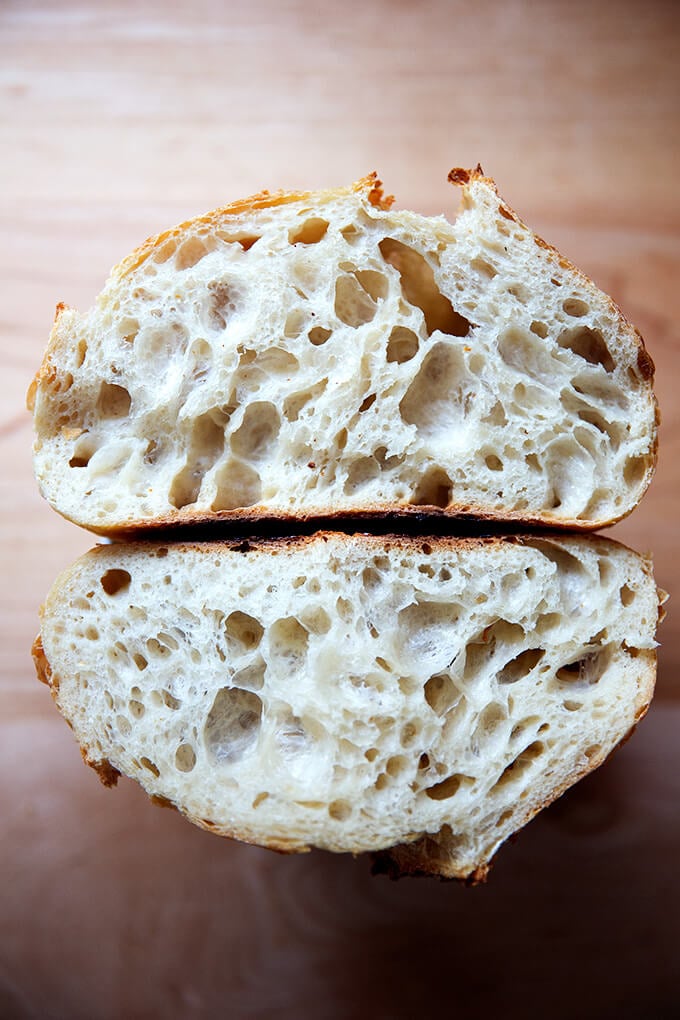
What is Sourdough Bread?
Sourdough bread is bread that has been leavened naturally, meaning it has been leavened by a sourdough starter as opposed to by commercial yeast or a chemical leavening agent such as baking powder or baking soda.
What is a Sourdough Starter?
A sourdough starter is a fermented mix of flour and water containing wild yeast and bacteria (lactobacilli). Provided it is healthy and active, a sourdough starter is what will make your bread rise.
You can make a sourdough starter from scratch in just about a week. I only recommend doing so if it currently is summer (or a very warm fall) where you are. While it is immensely satisfying to build a starter from scratch and subsequently use it to make a beautiful loaf of bread, I am a huge proponent of purchasing one for a few reasons, namely: when you purchase a starter, you are guaranteed to have a strong, vigorous starter from the start. In other words, you can start baking with confidence right away.
Here are three online sources for reasonably priced sourdough starters:
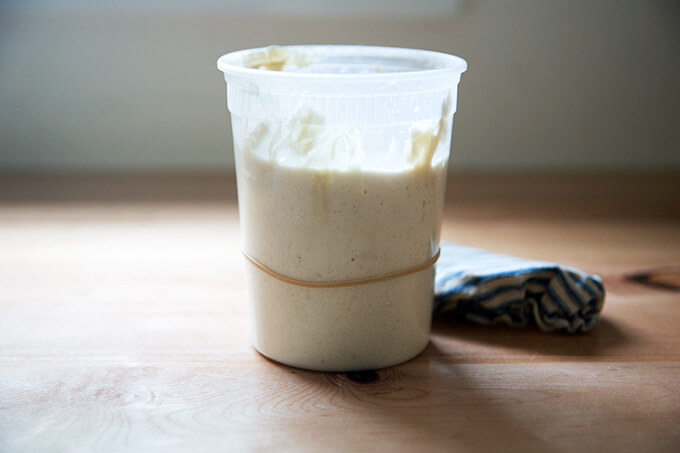
How to Feed a Sourdough Starter
In order to keep your starter alive, you have to feed it — it’s not unlike having a pet, but know this: caring for a sourdough starter is akin to caring for a very low maintenance pet, one that requires feeding only once every two to three weeks to stay alive, but one that requires feeding much more regularly if you like to bake frequently.
When I am not baking regularly, I store my starter in the fridge in the above-pictured vessel with its lid on. As noted above it can hang out there for 2-3 weeks (if not longer) without being touched. To wake it up or activate it, I like to feed it twice before using it. Often I’ll remove it from the fridge after dinner and feed it: this involves discarding most of it and replenishing it with equal parts by weight flour and water. (Please read this post, which explains in detail how to activate, feed, and maintain a starter.)
I will repeat this process in the morning — discard most of it; then replenish it with equal parts by weight flour and water. By midday, or when my starter has doubled in volume, it is ready to be used.
To store your starter, you should feed it, let it rise till it nearly doubles; then cover it and stash it in the fridge for 2 to 3 weeks until you are ready to use it again.
How Do I Know if My Starter is Ready to be Used?
If your starter doubles (or triples!) in volume within 4 to 8 hours after a feeding, it is ready to go. And ideally, you want to use your starter 4 to 8 hours after you feed it or when it has doubled. Every time I feed my starter, I place a rubber band around the vessel it is in to mark its height. This helps me see when it has doubled in volume and is, therefore, ready to be used.
If your starter is not doubling within 4 to 8 hours of feeding it, you should spend a few days strengthening it. This will involve discarding most of it — truly, don’t be afraid to be aggressive with how much you are discarding — and replenishing it with equal parts by weight flour and water. If you do this twice a day for several days, your starter will be in great shape.

What Equipment Do I Need?
At a minimum, you’ll need:
- a sourdough starter (see above)
- flour, bread flour if possible, my preference is King Arthur Flour
- salt
- water
Ideally, you’ll also have:
- digital scale
- straight-sided vessel for monitoring the bulk fementation
- bench scraper
- flour sack towels
- parchment paper
- banneton, such as this one or this one
- razor blade
- heavy lidded vessel, such as this one or this one
How to Make Sourdough Bread: A 5-Step Overview
There are essentially 5 steps to making sourdough bread. Each of these steps is explained in more detail below.
- Mix the Dough: This is simply a matter of combining water, sourdough starter, salt and flour in bowl, and stirring to form a sticky dough ball.
- Bulk Fermentation: This is just a fancy name for the first rise. During the first two hours of the bulk fermentation, you’ll perform a series of stretches and folds, which will give the dough strength and elasticity.
- Shape + Bench Rest: This step ends the bulk fermentation. You’ll shape the dough, let it rest, then shape it once more.
- Proofing the Dough: In this recipe, you’ll cold proof the dough in the fridge, ideally for 24 to 48 hours, though you can get away with a shorter proof.
- Scoring + Baking the Dough: After the dough has proofed, you’ll turn it out onto a piece of parchment paper, score it; then transfer it to a preheated baking vessel.
How This Sourdough Bread Recipe Differs From Others
This recipe differs from others in three main ways:
- No Autolyse. Why? I’ve never found employing an autolyse makes a big difference in the final texture of the bread, and I find the process of doing an autoylse frankly to be kind of a pain. What is an autolyse? Autolyse is a technique that calls for mixing flour and water together and allowing them to sit for several hours before adding the salt and sourdough starter. This process allows gluten to develop in dough prior to mixing. It also makes the dough more extensible. This is due to the hydrating effects of soaking the flour, as well as — and this is getting a bit scientific — from the enzymatic activity of protease, which breaks down some of the gluten that forms as the dough hydrates. This process weakens the dough’s elasticity, in turn increasing its extensibility. If you are after a super open crumb, autolyse is something to consider.
- 50% (roughly) Increase in Volume. If you come from the yeast-leavened bread world, you are accustomed to letting your dough double in volume during the first rise. When I first got into sourdough, I was applying this same method, and while I had success, I realized I was often letting my dough overferment — I was pushing the bulk fermentation too far. As soon as I stopped the bulk fermentation when the dough increased by 50-75% in volume, I got a much better oven spring.
- Long Cold Proof. After the bulk fermentation, you’ll shape the dough, and store it in the fridge ideally for 24 hours but it can hang out there for 48 hours or even a bit longer. This long, cold proof will make for a much lighter, open, airy crumb. (Note: If you were to leave the dough in the fridge for 12 hours or less, which you can do, the crumb will be tighter and denser.) After you remove the dough from the fridge, you score it, and transfer it immediately to the oven — there is no need to do a room temperature proof first.
Simple Sourdough Bread: A Step-by-Step Guide
Mix the dough.
To start, pour 375 grams of water into a bowl:

Add 50 to 100 grams of sourdough starter.

Stir to combine; then add 11 grams of salt:
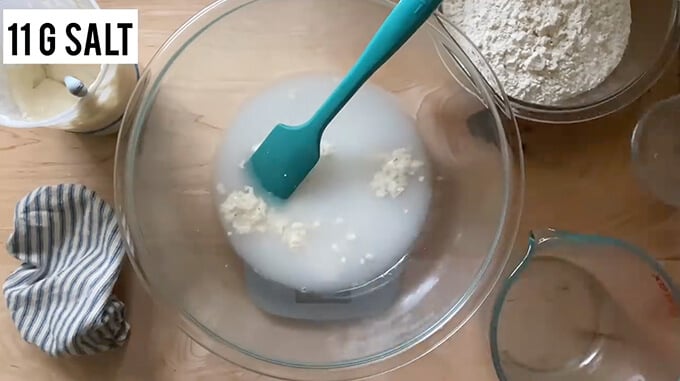
Finally, add 500 grams of bread flour:
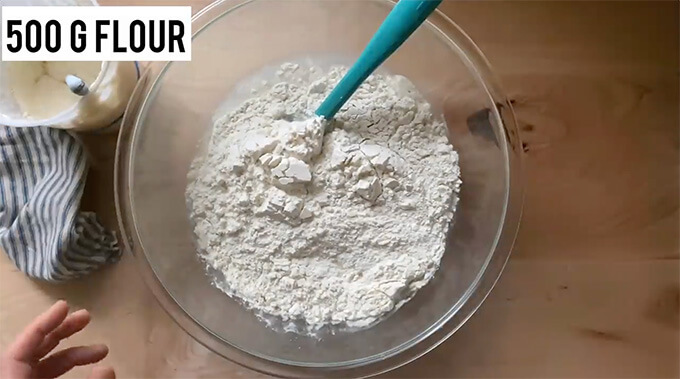
Stir to combine:
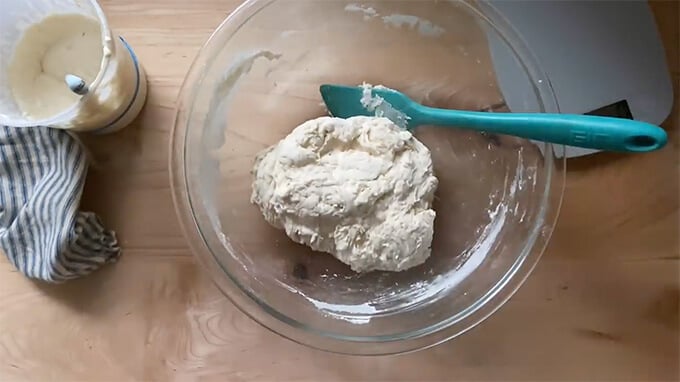
Let it Rise. (Bulk Fermentation)
Transfer the dough to a straight-sided vessel. Cover it, and let it rest for 30 minutes.

Perform a set of stretches and folds:
If time permits, perform four total sets of stretches and folds every 30 minutes for the first 2 hours. You should notice the dough getting stronger and more elastic with every set of stretches and folds. This is the 4th set:
After the 4th set of stretches and folds, cover the vessel — I love these Dot and Army cloth bowl covers for this — and set it aside until it increases in volume by 50% or so.
How long should the bulk fermentation take?
The time will vary depending primarily on the strength of your starter and the temperature of your kitchen. Rather than rely on a time period, however, you should rely on visual cues.
This video shows the dough nearly doubling (increasing by 100%) in volume, but the more I bake sourdough, the more I realize I have better success when I stop the bulk fermentation when the dough increases by 50%. It may take some trial and error to know what works best for you. You may find a 75% increase in volume is best or you may find that to be too long. Sourdough is all about experimenting and adapting based on your experiences.
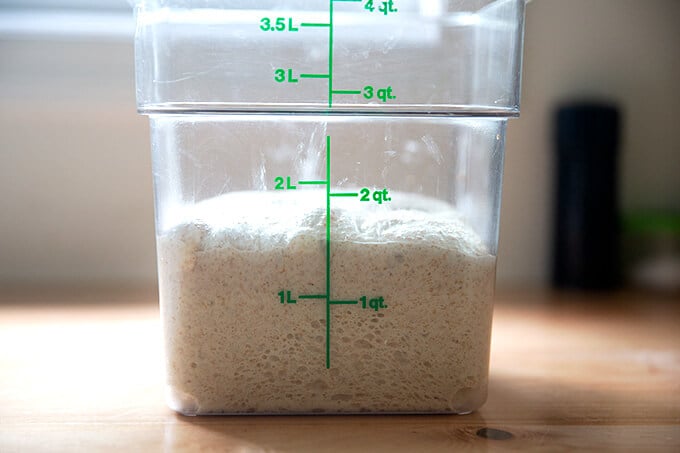
Shaping
Turn the dough out onto a lightly floured work surface:

Shape the dough gently into a round and let it rest for 20-40 minutes. This is called the bench rest.
Meanwhile, prepare a bowl or banneton with a flour sack towel and rice flour.
Proofing
Shape the round again; then place in prepared bowl for proofing. Transfer to fridge for 12 to 48 hours.
Bake It.
Remove bowl from fridge, and turn it out onto a sheet of parchment paper.
Score it.
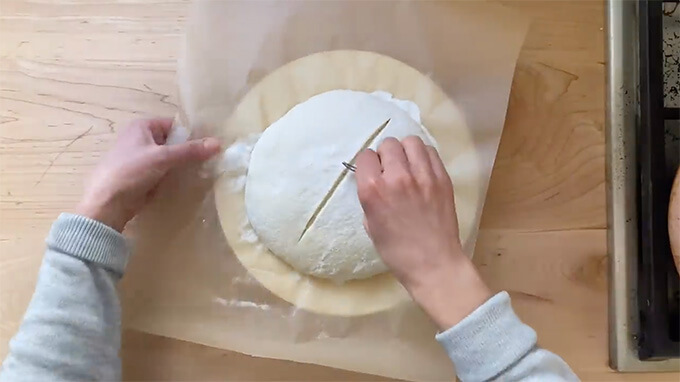
Transfer to preheated Dutch oven. Bake covered at 450ºF for 30 minutes; uncover, lower the temperature to 400ºF, and bake for 15 minutes more:

Remove from oven and let cool one hour before slicing.
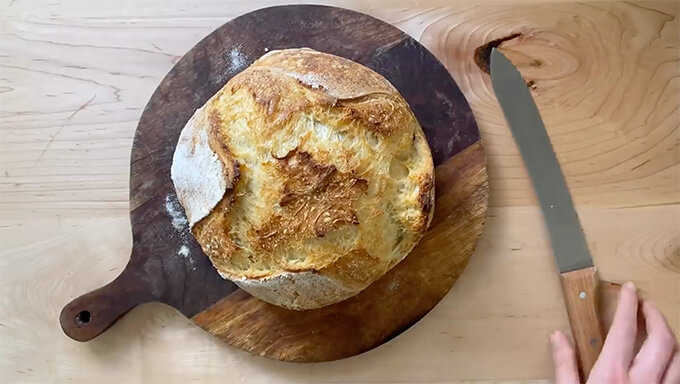
You’ll need a sharp knife (like this one or this one) when it’s time to slice:

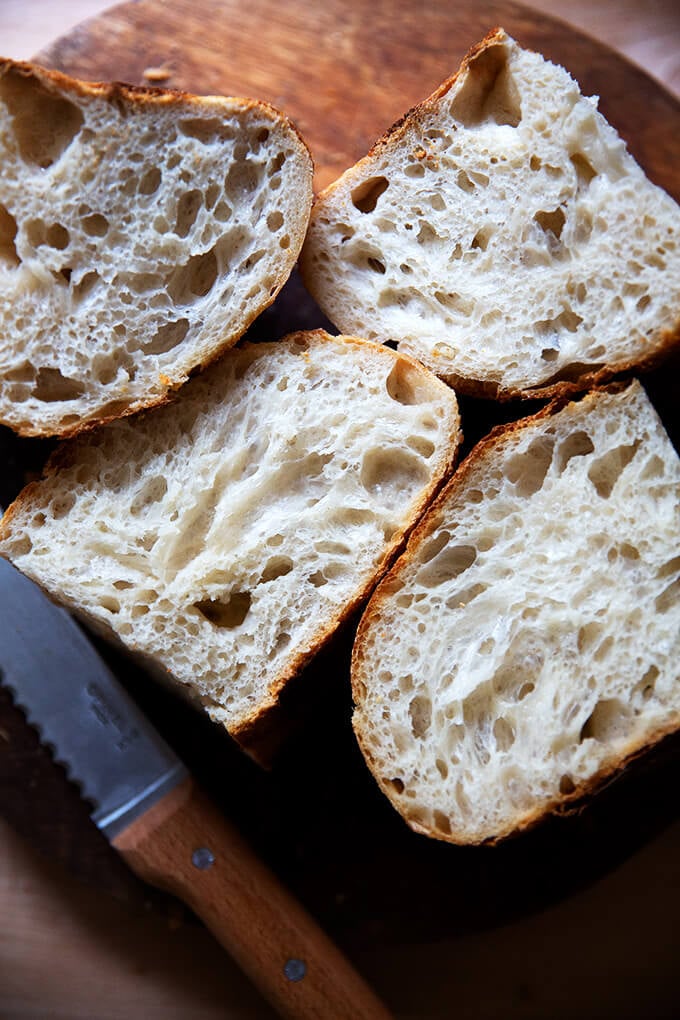
#1 Sourdough Bread Baking Tip
The refrigerator is your friend. Use it.
The most common mistake I see people make when making sourdough bread is letting the bulk fermentation go too long. They mix the dough at night; then wake up to dough that has tripled in volume and is a sticky mess.
To prevent over fermenting your dough, use your refrigerator as needed. After you complete the 4 sets of stretches and folds, you can put your dough in the fridge at any time. If you are tired and need to go to bed, transfer the dough to the refrigerator; then pick up where you left off in the morning: remove the dough from the fridge and let it continue to rise until it increases in volume by roughly 50%.
To accurately gauge when your dough has risen to roughly 50% in volume, I highly recommend investing in a straight-sided vessel such as this 4-qt Cambro (or this one, which is BPA-free!). When dough rises in a bowl, judging when it has risen sufficiently is tricky. There’s no question with a straight-sided vessel.

Troubleshooting: Where Sourdough Goes Wrong?
If you have ever had trouble baking sourdough bread, your issues likely stem from one of four places:
- Using a weak starter or not using starter at its peak.
- Using too much water relative to the flour.
- Over fermentation: letting the bulk fermentation (first rise) go too long.
- Using too much whole wheat flour, rye flour, or freshly milled flour.
I address each of these issues in this post: Why is my sourdough so sticky? 4 Common Mistakes, so please give it a read if you’ve had trouble with sourdough bread baking.

Sourdough Resources
- Sourdough Troubleshooting: This post addresses 4 common mistakes people make when baking sourdough bread and answers many FAQ’s as well.
- The Nutritional Benefits of Sourdough Bread + 6 Healthy Toast Topping Ideas
- Feeding Your Sourdough Starter
- Essential Equipment For Sourdough Bread Baking
- A tip for getting a more open crumb? Shape a batard as opposed to a round:
Other Sourdough Bread Recipes to Make
- Simple Sourdough Focaccia
- Sourdough Bread, Whole Wheat-ish
- Simple Sourdough Pizza
- Sourdough Detroit-Style Pizza
- Simple Sourdough Sandwich (or Toasting) Bread
- Sourdough Ciabatta
- Two Sourdough Discard Recipes: Sourdough Flour Tortillas & Irish Soda Bread
Sourdough Bread Baking Schedule
If you are new to sourdough bread baking, the timing of it all may feel overwhelming — you may find yourself asking: How can I do this without baking at midnight?
It’s a very good question! As noted above, your biggest friend when it comes to sourdough bread baking is your refrigerator. If after you’ve performed your stretches and folds, you don’t have time to stay up for the dough to complete the bulk fermentation, stick the vessel in the fridge and pick up where you left off the next day or the day after that.
Here is a rough schedule I like to follow. Adapt it to work for you:
Wednesday Evening: Remove starter from fridge. Feed it by discarding most of it and replenishing it with equal parts by weight flour and water.
Thursday Morning: Feed starter by discarding most of it and replenishing it with equal parts by weight flour and water.
Thursday Afternoon: Mix dough, let it rise. On Thursday evening, when the dough has completed the bulk fermentation, I’ll shape it and stick it in the fridge to proof. (As noted: If the dough hasn’t completed the bulk fermentation, I’ll stick the vessel in the fridge, and pick up where I left off the following day.)
Friday Evening or Saturday Morning: Score and Bake it. There is no need to let the dough come to room temperature before baking it. Simply remove it from the fridge, turn it out, score it, and bake it!

Homemade Sourdough Bread, Step by Step
- Total Time: 18 hours 45 minutes
- Yield: 1 loaf
Description
Inspired by The Clever Carrot
If you are new to sourdough, watch the step-by-step video here: Simple Sourdough Bread or in the post above.
Troubleshooting: If you have issues with your dough being too sticky, please read this post: Why is my sourdough so sticky? The 4 common mistakes.
Notes:
- You need an active sourdough starter. I have had success activating starters from:
- As always, I highly recommend investing in a digital scale before beginning any bread baking adventure.
- This is the Dutch Oven I use for sourdough bread. I used this Dutch oven for years, and it’s a great one, too.
- Flour sack towels are a great investment because they ensure your dough will not stick while it is proofing.
- I love using rice flour for dusting (as opposed to ap or bread flour) because it doesn’t burn. When you use a flour sack towel, however, you don’t need to use any flour.
- Find all of my sourdough essentials here: Essential Equipment For Sourdough Bread Baking
- I love a high-hydration dough, and I have great success using 380 grams of water in this recipe, so feel free to play around and push the hydration here.
- Salt: I have had success using both kosher salt and fine sea salt here. When I use kosher salt, I use the Diamond Crystal brand. When I use sea salt, I use the Baleine Fine brand. Regardless of the brand, I use 12 grams.
- Shaping: If you’re looking to get a more open crumb, try shaping a batard (as opposed to a round). Watch this video for guidance. Also: The recipe below follows the traditional shape once, rest, then shape again method. I often skip the preshape now and simply shape the dough once. I still get a nice open crumb.
How much Sourdough Starter to Use?
- Because my kitchen is cold for much of the year, I like using 100 g (1/2 cup) of starter as opposed to 50 g (1/4 cup). When determining how much starter to use, consider a few things: If you live in a warm, humid environment, 50 g should suffice. If you plan on doing an overnight rise, 50 g also should suffice. If you want to speed things up or if you live in a cold environment, consider using 100 g starter. Note: If you use 100 g of starter, your dough may rise more quickly, so keep an eye on it. As always, rely on the visual cues (increasing in volume by 50%) when determining when the bulk fermentation is done.
- A straight-sided vessel makes monitoring the bulk fermentation especially easy because it allows you to see when your dough has truly doubled.
Ingredients
- 50 – 100 g (1⁄4 – 1/2 cup) bubbly, active starter — I always use 100 grams, see notes above
- 375 g (1 1/2 cups plus 1 tbsp) warm water, or more, see notes above
- 500 g (4 cups plus 2 tbsp) bread flour
- 9 to 12 g (1.5 – 2.5 teaspoons) fine sea salt, see notes above
Instructions
- Make the dough: Whisk the starter and water together in a large bowl with a fork or spatula. Add the flour and salt. Mix to combine, finishing by hand if necessary to form a rough dough. Cover with a damp towel and let rest for 30 minutes.
- Stretch and fold: After 30 minutes, grab a corner of the dough and pull it up and into the center. Repeat until you’ve performed this series of folds 4 to 5 times with the dough. Let dough rest for another 30 minutes and repeat the stretching and folding action. If you have the time: do this twice more for a total of 4 times in 2 hours. Note: Even if you can only perform one series of stretches and folds, your dough will benefit. So don’t worry if you have to run off shortly after you mix the dough.
- Bulk Fermentation (first rise): Cover the bowl with a towel and let rise at room temperature, about 8 to 10 hours at 70°F (21°C) or even less if you live in a warm environment. The dough is ready when it has increased by 50% in volume, has a few bubbles on the surface, and jiggles when you move the bowl from side to side. (UPDATE: In the past I have recommended letting the dough rise until it doubles in volume. If you’ve had success with this, continue to let the dough double. Recently, I have been stopping the bulk fermentation when the dough increases by 50% in volume, and I feel I am actually getting better oven spring in the end.) (Note regarding timing: If you are using 100 g of starter, the bulk fermentation may take less than 8 to 10 hours. If you live in a warm, humid environment, the bulk fermentation may take even less time. In the late spring/early summer, for example, my kitchen is 78ºF and the bulk fermentation takes 6 hours. It is best to rely on visual cues (increase in volume by roughly 50%) as opposed to time to determine when the bulk fermentation is done. A straight-sided vessel makes monitoring the bulk fermentation especially easy because it allows you to see when your dough has truly increased in volume by 50%.)
- Shape (See notes above): Coax the dough onto a lightly floured surface. Gently shape it into a round: fold the top down to the center, turn the dough, fold the top down to the center, turn the dough; repeat until you’ve come full circle. If you have a bench scraper, use it to push and pull the dough to create tension.
- Rest: Let the dough rest seam side up rest for 30 minutes. Meanwhile, line an 8-inch (20-cm) bowl or proofing basket with a towel (flour sack towels are ideal) and dust with flour (preferably rice flour, which doesn’t burn the way all-purpose flour does). Using a bench scraper or your hands, shape it again as described in step 4. Place the round into your lined bowl, seam side up.
- Proof (second rise): Cover the dough and refrigerate for 1 hour or for as long as 48 hours. (Note: I prefer to let this dough proof for at least 24 hours prior to baking. See video for the difference in the crumb of a loaf that has proofed for 6 hours vs one that has proofed for 24 hours. If you choose to proof the dough in the fridge for an extended period of time, you may want to tuck it into a loosely tied bag — produce bags from the grocery store are great for this purpose — to ensure the dough does not dry out. The original recipe calls for a 1-hour rise, and if you have had success doing that, by all means, keep doing it.)
- Place a Dutch oven in your oven, and preheat your oven to 550°F (290°C). Cut a piece of parchment to fit the size of your baking pot.
- Score: Place the parchment over the dough and invert the bowl to release. Using the tip of a small knife or a razor blade, score the dough however you wish — a simple “X” is nice. Use the parchment to carefully transfer the dough into the preheated baking pot.
- Bake: Lower the oven to temperature to 450ºF (230ºC). Carefully cover the pot. Bake the dough for 30 minutes, covered. Remove the lid, lower the temperature to 400ºF (200ºC) and continue to bake for 10 – 15 minutes more. If necessary, lift the loaf out of the pot, and bake directly on the oven rack for the last 5 to 10 minutes. Cool on a wire rack for 1 hour before slicing.
- This loaf will stay fresh up to 3 days stored at room temperature in an airtight plastic bag or container. It freezes beautifully, too.
Notes
- This recipe has been adapted from Artisan Sourdough Made Simple. Changes I have made to the original recipe include:
- Using 11 g salt as opposed to 9 g.
- Performing 4 stretch and folds during the first 2 hours of the bulk fermentation, which build strength in the dough.
- Doing a cold proof for at least 24 hours before baking, which produces a lighter airier crumb. In the video, you can see the difference between the crumb of a loaf that has proofed for only 6 hours vs a loaf that has proofed for 24 hours.
- Finally, I like preheating my Dutch oven, which makes a crisper crust.
- Prep Time: 18 hours
- Cook Time: 45 minutes
- Category: Bread
- Method: Oven
- Cuisine: American
This post may contain affiliate links. Please read my disclosure policy.




















3,032 Comments on “Homemade Sourdough Bread, Step by Step”
Ok, I’ve tried for probably a year to make a good sourdough and this recipe is finally IT! Successful rise. Beautiful color. Feeling very accomplished! Thank you!
Wonderful to hear, Tara! Thanks so much for writing. The feeling of accomplishment is REAL!
Hi Ali. Thank you for your sourdough bread recipe. Your recipe helped me bake bread that my friends and family really enjoy. I’ve had to make some adjustments as I live at 7000 feet in New Mexico. Also, I substituted the salt for everything bagel seasoning. It’s a big hit.
Ed Saienni
That sounds amazing! Love this idea. Great to hear the recipe worked (with your adjustments) at such high elevation. Thanks so much for writing!
This was my first sour dough bread and it turned out beautiful! I had to take pictures and send to my family and friends. Ha! Thank you for a great recipe.
Great to hear, Alana! Thanks for writing 🙂 🙂 🙂
Best sourdough recipe. The only one I use. Tried a few others and always come back to this one.
Great to hear, Terri! Thanks so much for writing 🙂
I will be attempting this recipe for my first ever sourdough next week. Exciting!! One question…when you say let the dough rise 50%, is that 50% from the volume after the four series of folds or 50% from the volume when the mixed dough is first transferred to your straight sided vessel?
Hi! I guess I would say after you transfer the dough. You likely won’t see much growth in volume during those first two hours while you are stretching and folding. Also know that it’s OK if it goes a little about 50% in volume. 50-75% increase is what I generally recommend.
Hello, I have been making sourdough bread for 3 years but have never been able to do a rise for 24 hours or more because my dough will flop in the fridge. Is there something wrong with my dough or is my sourdough starter not strong enough? My mum and I are trying to find a solution to have a longer resting sourdough. How does the fridge work?
Thanks for your consideration,
Isaac
Hi Isaac! Can you tell me about your starter? Is it homemade? What are you feeding it? How long does it take for it to double in volume after a feeding? Also, what type of flour are you using in your bread.
It sounds as though your dough is overfermenting. My initial thoughts are: 1. Work on your starter and get it very strong and active. 2. Shorten your bulk fermentation. Don’t let the dough rise above 50% in volume. 3. Then try shaping and cold proofing for 24-48 hours.
It was my first time making sourdough and this turned out beautifully!
Great to hear, Kendra! Thanks so much for writing 🙂 🙂 🙂
Tried and failed with sourdough. But here I found instant success!!! The family loves my bread. As a diabetic, I try to stick to only sourdough bread and now I have the skills to make it at home. Thank you so much for the step by step easy to follow guide.
So nice to read this, Matt 🙂 Thanks so much for writing. Great to hear the family approves, too!
Hey:) so I was making this bread and I used my scale the first time and it seemed like I used way under 4 cups of flour. I then thought maybe my scale was off but I tested it and it was ok, but when I googled 500 grams of flour to cups it’s 3 cups plus 2 tbsp not 4😎 so I think it’s just a typo ❤️
Hello! I’ve never baked sourdough before and wanted to use your recipe. Do I put the dough in the oven while it’s still 550 degrees and just turn it down to 450 immediately or do I wait for the oven to cool to 450 before officially baking?
No need to wait! Put it in the oven when it’s still at 550F.
Thank you for the wonderful and wonderfully simple recipe. I successfully made my first ever sourdough boule today. It was tangy and chewy with a nice crumb and a crunchy crust. Yum!! After going through the process, I have a couple questions. First, my starter reliably doubles in just over 4 hours, but will continue its rise before peaking at around 6 hours. If I want to get more volume after baking, should I use it at 4 hours or 6 hours? Second, I have a 9-inch banneton. It seems a little large for this recipe. A smaller one would give me a less flat cold proofed dough. Can I expect that to translate to more upward lift upon baking? Finally, do you keep the dough covered in something airtight during the long cold proof to prevent the dough from getting dry? Thanks again. It’s a whole new world!!
Hi Steve! Great to hear all of this! Questions answered below:
First, my starter reliably doubles in just over 4 hours, but will continue its rise before peaking at around 6 hours. If I want to get more volume after baking, should I use it at 4 hours or 6 hours?
Try it at 6 hours! I can’t say for sure, but sourdough is all about experimenting, adapting, etc. See what sort of lift you get when you use your starter at 6 hours — you very well might get better results.
Second, I have a 9-inch banneton. It seems a little large for this recipe. A smaller one would give me a less flat cold proofed dough. Can I expect that to translate to more upward lift upon baking?
It should, yes!
Finally, do you keep the dough covered in something airtight during the long cold-proof to prevent the dough from getting dry?
If you’ve found your loaf has developed a hard crust during its time in the fridge, you can tuck the entire shaped loaf into a plastic bag, like a produce bag from the grocery store. You can clip it closed or tie a knot.
I love this recipe so much. I’ve already made it many times. Yummy.
I was wondering though, how you would make sourdough hotdog or hamburger buns.
When I look it up, all I can find are people using yeast. That takes all the joy and flavor out of sourdough in my opinion. Thank you.
Hi Ken! I don’t have a recipe for buns unfortunately. I think you’d need to add some fat (butter, oil), eggs, and maybe a teensy amount of sugar. Like others, I have a yeasted brioche bun recipe that I use for burgers all summer long. If I come across a sourdough recipe I like, I will be in touch.
Hi! I found your recipe when I began baking sourdough and without a doubt yours is the recipe I use over and over. Lately I’ve found that my dough comes out pretty wet. This last time I made two doughs side by side using the containers you use in this recipe… where you can tell if it rose 50%. I was busy that day and wanted to get each going in the first bulk rise. I took one, which had risen about 50% and put it out on the counter to stretch and fold and let it bench rest. This was still rather wet and sticky. The second one hadn’t quite risen like the other one, but I took it out anyway to do the stretches and let it bench rest. This was the dryer, tighter one. I did the two day fridge proofing and I just baked the dryer, tighter one and it came out looking phenomenal. Better than any of my wetter doughs come out. The wetter one is baking right now but when I scored it I could tell it spread out like my other loaves, so it seems like it will turn out like before. The dryer one looks gorgeous and I love its shape. Do I continue to not let it rise quite 50%, taking it out much sooner than the 50% rise point? Honestly I thought that the dryer one would not turn out well… it just seemed too dry. I haven’t tasted it yet but I am really impressed with how it looks. I’m in Texas and it’s warm here, but I do keep the house cool. Sometimes when I’m baking or cooking, the kitchen warms up and does effect the way that first bulk rise happens. Any thoughts would be appreciated!!! Thank you!
Hi Ryan! Great to hear all of this. The answer is really up to you! If you liked the flavor and texture of the dryer one in the end, then keep doing that. Lots of sourdough bread recipes call for a 30-50% increase in volume, so there’s no right way to do it. If you are happy with the results — and it sounds as though you are — then yes, definitely keep doing the shorter bulk fermentation. This is what sourdough is all about — trying different things and adapting until we find the method we love. Hope that helps! Thanks for writing.
Hi, this is a great source of information rei bread. I am using your receipt all the time with great success. Thank you. I am just wonder can I freeze the dough before baking, and if yes do you have any tips?
Great to hear, Serguei! I would not recommend freezing the unbaked dough — sourdough dough generally does not freeze well. You can freeze the baked loaf — it freezes beautifully.
Best sourdough recipe. The only one I use. Tried a few others and always come back to this one.
I’ve never been successful at making bread until recently. This recipe is absolutely foolproof! I’ve made it numerous times in the past month, and it’s turned out delicious every time. I’ve also cut the dough in half and made 2 smaller loaves to give to friends/family. I followed the directions as printed (75 grams starter), let it cold proof for 40-48 hours, and cooked it in a cast iron dutch oven. Thank you so much – I feel like an expert and am ready to try some other bread recipes now. PS. The video was extremely helpful!
So wonderful to hear this, Kim! Thanks so much for writing and sharing your notes. Love the idea of making two smaller loaves to gift 🙂 🙂 🙂
Hi..thanks for your recipe. Could I add a bit olive oil so the bottom is more soft? And how much could I add? Thanks
I think you could add 2 tablespoons of olive oil to the dough… maybe even a bit more. I’d say no more than 4 tablespoons.
Hi Alexandra. I have been working with your recipe for a few weeks now and am having some bulk fermentation issues. My last attempt took forever. 12 hours bulk fermenting with a rise clearly less than 20%. Everything seemed great through the stretch/folds. After 12 hours, either the dough or I was going into the fridge. I choose the dough and took it back out for another 5 hours in the morning. By then the dough had risen just a bit over 20% and there were large, medium and small bubbles looking in from the side of the straight sided vessel, and the dough still seemed to pass the poke test. It was still dome shaped. 17 hours seemed pretty insane for a moderate room temperature so I tried to shape the dough. It was very wet and sticky. Practically unshapeable.
I’m trying to sort through the potential problems.
The starter is five weeks old. It doubles in 4 hours and nearly triples in 6 hours. Textbook! It is fed at a 1:4:4 ratio with half rye flour and half organic unbeached white. In this instance I tried to use it at around 6 hours near peak with 100% bread flour as per your recipe.
Could my starter be too weak? Could the rye flour be masking the weakness of the starter and the starter lacks enough “ooomph” when the food source becomes all white flour?
I have been using 75 grams of starter. If the starter is too weak, would going to 100 grams be worth a try?
17 hours bulk fermenting seems like a lot. Is that common? The kitchen is not cold by any stretch. I’m told wet, sticky dough often implies overfermentation, but the poke test, the bubbles and the smell don’t really indicate that. If I up the starter by 25 grams, should I consider knocking down the water by 5%?
Finally, if you put your dough in the fridge before returning the next morning to finish the bulk, does that reduce the time needed to cold ferment, since the bacteria are still doing their thing while the yeast mellows out?
Thank you for your patience with my many questions. I’m enjoying this process a great deal, and even a not perfect loaf is pretty tasty!
Hi Steve! Great to hear you are enjoying the process.
A few thoughts: Rye flour (even when it’s just in the starter) definitely will weaken the gluten structure of the dough overall. I might suggest trying to make a starter with 100% bread flour. I also think you should try 100 grams of starter. Don’t change the water amount yet. Try those two things first, then see how the dough behaves.
Are you using a straight-sided vessel for the bulk fermentation?
It does sound as though your dough is over fermenting.
I’m new to sourdough and loving all your recipes! The flavor with your recipe turns out great for me, but my loaves always turn out like a flat blob? Ive tried other recipes from other sites and they puff up nicely, I wonder what I’m doing wrong?
How does the hydration level of this one compare to the others you’ve tried?
We loved your recipe. Tried others but this is simple and tastes great! After doing way too much reading on sourdough just wondering what kind of salt do you use ?
Great to hear Jo Ann! I use Diamond Crystal kosher salt most of the time. Sometimes (usually after reading something about sourdough I’ve stumbled upon) I use fine sea salt (that blue tubular container with a whale on it, Bailene brand). Not sure I can tell the difference!
This is by far the best sourdough recipe I have made to date! I started making sourdough 2 years ago. I stopped for about 6months because I couldn’t find a recipe that worked just right. I was so discouraged. I came across this recipe and it was so beautifully detailed that I decided to give it a shot. We just cut into the first loaf, and it was gone within an hour! The texture was phenomenal , the inside was so airy and the outside so crunchy! I already have another loaf in the bulk rise stage and I can’t wait for it to be done. Thank you so much for sharing this!
Oh yay! Wonderful to hear this, Dani 🙂 🙂 🙂 Thanks for writing.
Hey there! I am making the recipe for the first time. I am a little bummed though, the total time on the recipe states 18 hrs and 45 min. But now that i have let it rise for the 8-10 hours, i need to refrigerate for another 24 hrs? I was expecting to make the bread the next day and now i cannot. That was a little deceiving in my opinion, maybe you should add both rise times in the total time. Thank you.
Hi! You will get the best results if you chill it for 24-48 hours before baking it, but the original recipe doesn’t call for that chilling period. So, you can bake it if you want without chilling it: simply let the shaped boule or batard proof at room temperature for 4 to 5 hours after the bulk fermentation; then bake it. I’ve just found over the years I get a much lighter, more open crumb when I cold proof for 1 to 2 days.
Thanks Alex. This recipe is so easy and it turns out so good. All my family and friends love it.
Great to hear, Agnes! Thanks for writing 🙂
Hi Ali!!
I’m about 21 hours into the 2nd rise, and do you pull the dough out 30 minutes before putting it in the oven, or it’s literally oven/pan are preheated, transfer and bake? Hope that makes sense.
Hi! No need to bring it to room temperature. Score the cold dough; then into the hot preheated Dutch oven it goes. Hope it works out well for you!
My very first sourdough loaf was a great success! Thanks for the detailed outline and pics to tee me up for success. The timing is completely different from yeast baking and reading this helps build confidence to start using sourdough.
Great to hear Tam! Thanks so much for writing 🙂 🙂 🙂 Sourdough timing definitely takes some getting used to, but once you get the visual cues down, it all becomes second nature.
Love this recipe! Finally gave me the results I’ve been looking for, so I thank you for that! I wonder if you have ever tried doubling it to make two loaves? I’m tempted to try it, but just don’t know how it might affect the proofing. Also, I would like to make into more of a batard shape. Do you think the quantity of dough would work in a 9×5-inch or 11×5.5 inch banneton?
Great to hear, Stacey! I have doubled this recipe successfully. As long as you have a big enough vessel to handle the bulk fermentation, it works just fine. I almost always shape batards now when I make this recipe. Did you see the batard-shaping video? The smaller size 9×5-inch banneton is better for this recipe.
Great recipe! I have made it several times with pleasing results; however, the sourdough flavor is weak. Is this due to the refrigeration? Also, it does not raise in the fridge in 48 hours. Should I be looking for it to increase in volume?
Hi Stan! Sourdough dough does not change very much in the fridge, so it is normal that your loaf did not rise.
The sour flavor actually, in my experience, gets stronger the longer it spends in the fridge. Here is something else you can try:
Use less starter. It’s counterintuitive, but using less starter usually means your bulk fermentation will be longer, which means your starter will go through its food source at a slower rate and therefore produce more acetic acid along the way.
That said, in my experience, I see little difference in both the length of the bulk fermentation and the resulting sourness in a loaf whether I use 50 g or 100 g of starter in a recipe. But if you are after more sour flavor, using less starter may be something to try.
If I want to add rosemary and Kalamata olives ,
When would I do this ? Thank you
Hi Georgia! I would add them after you’ve done two sets of stretches and folds.
Holy Cow!!! The best and easiest sourdough recipe I’ve tried in 3 years! So, So, So good!!!! Am already prepping to make another loaf!
Woohoo! Great to hear, Sammie 🙂 🙂 🙂 Thanks so much for writing.
This recipe is amazing! As a newbie to sourdough baking, I found it so easy to follow and have been using it since last year. My husband is obsessed and we now make 2 loaves at a time as we go through it so quick. One thing we could improve on is not burning the bottom, it can be so difficult to slice sometimes! We have an enamelled Dutch oven so not sure if this affects the temperature? If you have any tips to help with this we would really appreciate it! Thanks for an awesome recipe 🙂
Great to hear, Joanne! I have some tips on this Troubleshooting post for avoiding a burnt bottom, but my biggest tip is to simply lower the oven temperature from the start: preheat your pan at 450ºF. See if that works first. But do read the troubleshooting post bc there are more ideas there 🙂
I’m in the middle of making this atm, and realised my oven only goes to 260degrees c. When your recipie calls for 290. Any advice on alternatives and timing? Thanks
Just use the 260ºC! It should be fine.
How did it turn out?